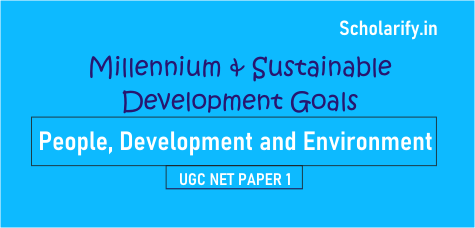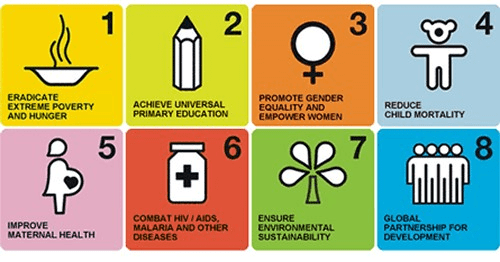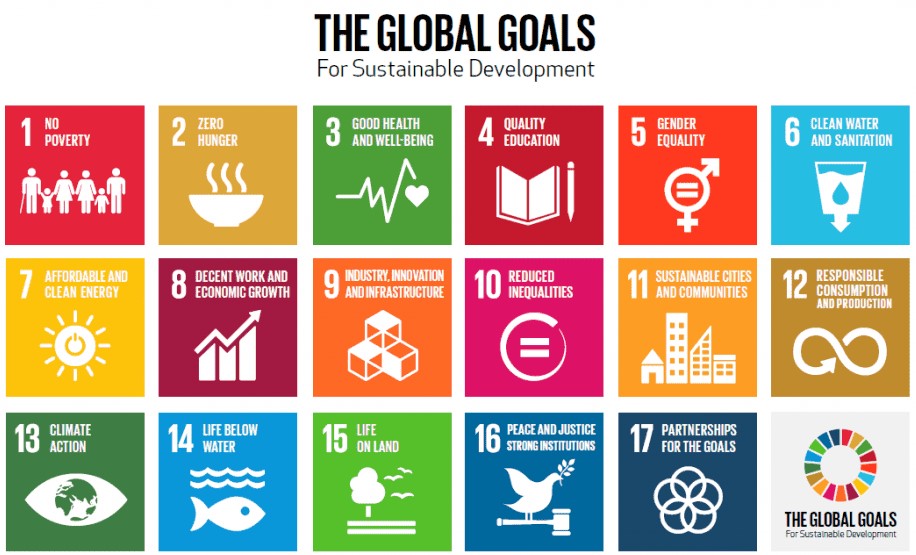
Before going to explain the topic of Millennium and Sustainable Development Goals, we will discuss development and environment.
There is a close link between environment and sustainable development which is used in the broad perspective and the overall development of human beings without any distinction.
Development and Environment
The World Conservative Strategy initiated by the United Nations Environment Programme (UNEP), the Worldwide Fund for Nature (WWF) and International Union for Conservation of Nature (IUCN), provided the platform for international debate on sustainability.
The most noteworthy step towards sustainable development is the publication of an international report titled “Our Common Future” by World Commission on Environment (WCED) in 1987. This is commonly known as “The Brundtland Report”. The report defined sustainable development as “Development that meets the needs of the present, without compromising the ability of future generations to meet their own needs”.
UGC NET Study Materials for Paper 1 (eBook with MCQ) ⇒ Download Now |
According to this report, the major objective of development should be to ensure the satisfaction of human needs and aspirations of a material kind. It emphasized the fact that over exploitation of resources may compel human societies to compromise their ability to meet the essential needs of their people in future.
Settled agriculture, the diversion of watercourses, the extraction of minerals, the emission of heat and noxious gases into the atmosphere, commercial forests, and genetic manipulation, were all mentioned in the report as examples of human intervention in the natural system during the course of development. It called upon all countries to adopt the objective of sustainable development as the overriding goal and test of national policy and international cooperation.
Three Earth Summits were held under the auspicious of the United Nations Conference on Environment and Development (UNCED) in 1992, 1997 and 2000. Over 170 countries participated in these Summits renewed their commitment to sustainable development aiming at “ giving special attention to the worldwide conditions that pose severe threats to the sustainable development of the people, which include: chronic hunger; malnutrition; foreign occupation; armed conflict; illicit drug problems; corruption; natural disasters, communicable diseases, in particular, HIV/AIDs, malaria and tuberculosis”.
After these Summits, sustainable development has become a universal theme to describe the amalgamation of environmental opportunities and human wisdom.
Dimensions of Sustainable Development
Sustainable development has many dimensions. Some of them are briefly described in the followings:
Social Dimension
- Workers‟ health and safety.
- Impact on local communities, quality of life.
- Benefits to disadvantaged groups, for example, the disabled.
Economic Dimension
- Creation of new markets and opportunities for sales growth.
- Cost reduction through efficiency improvements and reduced energy and raw material inputs.
- Creation of additional value.
Environmental Dimension
- Reduced waste, effluent generation, emissions into the environment.
- Reduced impact on human health.
- Use of renewable raw materials.
- Elimination of toxic substances.
Millennium Development Goals
In September 2000, at the UN Millennium Summit, the UN General Assembly adopted the United Nations Millennium Declaration. The Declaration, which called for a global partnership to reduce extreme poverty, was the first-ever global strategy with quantifiable targets to be agreed upon by all UN member states and the world’s leading development institutions. To support the Declaration, former UN Secretary-General Kofi Annan established eight accompanying objectives to combat poverty, hunger, disease, illiteracy, environmental degradation, and discrimination against women. These objectives (listed below) were set with a deadline of 2015 and became known as the Millennium Development Goals (MDGs).
The Eight Millennium Development Goals are:
- Eradicate extreme poverty and hunger
- Achieve universal primary education
- Promote gender equality and empower women
- Reduce child mortality
- Improve maternal health
- Combat HIV/AIDS, malaria and other diseases
- Ensure environmental sustainability
- Develop a global partnership for development

Key Millennium Development Goals (MDGs) achievements:
- More than 1 billion people have been lifted out of extreme poverty (since 1990)
- Child mortality dropped by more than half (since 1990)
- The number of out of school children has dropped by more than half (since 1990)
- HIV/AIDS infections fell by almost 40 per cent (since 2000)
From MDGs to Sustainable Development Goals
The MDGs were concrete, specific and measurable, and therefore helped establish some priority areas of focus in international development. But that was also one of their biggest criticisms: by being so targeted, they had left out other, equally important, areas.
Despite the criticism, significant progress has been made over the past 15 years, especially when it comes to the goals of eradicating poverty and improving access to education. That progress, however, has been very uneven, with improvements often concentrated in specific regions and among certain social groups. A 2015 UN assessment of the MDGs found they fell short for many people: “The assessment of progress towards the MDGs has repeatedly shown that the poorest and those disadvantaged because of gender, age, disability or ethnicity are often bypassed.”
Sustainable Development Goals
At the historic UN General Assembly Summit in September 2015, the 2030 Agenda for Sustainable Development was adopted by the UN’s 193 member states. The 17 Sustainable Development Goals (SDGs) and their 169 targets are part of this agenda.
The Sustainable Development Goals are a bold, universal agreement to end poverty and all its dimensions and craft an equal, just and secure world – for people, planet and prosperity. The SDGs have been developed through an unprecedented consultative process that brought national governments and millions of citizens from the globe together to negotiate and adopt this ambitious agenda.
The Goals and targets will stimulate action for the next 15 years up to 2030 in areas of critical importance for humanity and the planet.
5 Ps of Sustainable Development
Planet: Protect our Planets natural resources and climate for future generations.
People: End poverty and hunger in all forms and ensure dignity and equality.
Prosperity: Ensure prosperous and fulfilling lives in harmony with nature.
Peace: Foster peaceful, just and inclusive societies.
Partnership: Implement the agenda through a solid global partnership.
The 17 Sustainable Development Goals:
There are 17 sustainable Development Goals to achieve by 2030 to all its member countries.

1. No Poverty: End poverty in all its forms everywhere.
2. Zero Hunger: End hunger, achieve food security and improved nutrition, and promote sustainable agriculture.
3. Good Health and Well-being: Ensure healthy lives and promote well-being for all at all ages.
4. Quality Education: Ensure inclusive and equitable quality education and promote lifelong learning opportunities for all.
5. Gender Equality: Achieve gender equality and empower all women and girls.
6. Clean Water and Sanitation: Ensure availability and sustainable management of water and sanitation for all.
7. Affordable and Clean Energy: Ensure access to affordable, reliable, sustainable and modern energy for all.
8. Decent Work and Economic Growth: Promote sustained, inclusive and sustainable economic growth, full and productive employment, and decent work for all.
9. Industry, Innovation, and Infrastructure: Build resilient infrastructure, promote inclusive and sustainable industrialization, and foster innovation.
10. Reducing Inequality: Reduce inequality within and among countries.
11. Sustainable Cities and Communities: Make cities and human settlements inclusive, safe, resilient and sustainable.
12. Responsible Consumption and Production: Ensure sustainable consumption and production patterns.
13. Climate Action: Take urgent action to combat climate change and its impacts (noting agreements made by the UNFCCC forum).
14. Life Below Water: Conserve and sustainably use the oceans, seas and marine resources for sustainable development.
15. Life on Land: Protect, restore and promote sustainable use of terrestrial ecosystems, sustainably manage forests, combat desertification and halt and reverse land degradation, and halt biodiversity loss.
16. Peace, Justice, and Strong Institutions: Promote peaceful and inclusive societies for sustainable development, provide access to justice for all and build effective, accountable and inclusive institutions at all levels.
17. Partnerships for the Goals: Strengthen the means of implementation and revitalize the global partnership for sustainable development.
For Further Study: Details about SDGs
Sustainable Development Goals (SDGs) and India
The Sustainable Development Goals (SDGs) were adopted in September 2015 as a part of the resolution, ‘Transforming our world: the 2030 Agenda for Sustainable Development’. India is committed to achieving the 17 SDGs and the 169 associated targets, which comprehensively cover social, economic and environmental dimensions of development and focus on ending poverty in all its forms and dimensions. At the Central Government level, NITI Aayog has been assigned the role of overseeing the implementation of SDGs in the country.
To spread awareness about the Goals, bring together stakeholders and build capacities for the realization of SDGs, NITI Aayog has organized several national and regional level consultations
Achievements in the Year 2018-19
National level consultations
- In February 2018, a National Workshop on capacity development for localising the SDGs was held. Union Territories (UTs) and 23 states, as well as other relevant stakeholders, participated in the workshop.
- Another National Consultation on SDG 1 and associated targets was held in March 2018, which saw Central Ministries, States/UTs and other stakeholders discuss policies, implementation strategies and best practices.
- The private sector is an important stakeholder in the implementation of SDGs. Recognising this, a government and business partnership conclave were held in August 2018 to sensitise businesses and industries in the private sector and analyse their programme strategies on various SDGs.
- The Task Force on Implementation of SDGs held two meetings to take stock of SDGs at the national level.
Regional level forums on SDGs
- The central platform for international follow-up and review of the 2030 Agenda is the High-Level Political Forum (HLPF), which meets annually under the auspices of the UN Economic and Social Council (ECOSOC).
- As a regional preparatory for the HLPF, the Asia-Pacific Forum on Sustainable Development (APFSD) was held for the fifth time at Bangkok in Mar 2018, under the chairmanship of Dr. Rajiv Kumar, Vice Chairman, NITI Aayog. Around 600 participants joined the event, where States, United Nations bodies, international organizations and other stakeholders engaged in deliberations on the theme, “Transformation towards sustainable and resilient societies”.
South Asia Forum on Sustainable Development
- The South Asia Forum on the Sustainable Development Goals, 2018 was co-organized by NITI Aayog, United Nations Economic and Social Commission for Asia and the Pacific (UNESCAP) and RIS in October 2018, to enhance awareness on challenges and opportunities for the implementation of the 2030 Agenda; generate reflections on sub-regional perspectives and good practices on the Goals under review at the HLPF in 2019, and identify ways to strengthen partnerships and implementation efforts.
- Key focal areas of the deliberations were the scope and options for improving the regional/sub-regional policy environment for implementation of SDGs and capacity development of key stakeholders.
Revised Mapping of Ministries, Centrally Sponsored and Central Sector Schemes
- A mapping exercise was of Central Ministries and Centrally Sponsored /Central Sector Schemes was revised to include more schemes and reflect more comprehensively the interconnectedness of SDGs.
Monitoring Progress on SDGs
- NITI Aayog finalised and released the SDG India Index – Baseline Report 2018 in December 2018, to track the progress of all the States and Union Territories (UTs) on the priority indicators, measuring their achievements and failures on the outcomes of the interventions and schemes of the central Government.
- The SDG India Index has been developed to provide a holistic view on the social, economic and environmental status of the country and its States and UTs. It will also go a long way in helping analyse and identify best practices and priority areas, giving direction to developmental policies.
Refs:
https://www.fao.org/3/CA3121EN/ca3121en.pdf
https://www.aessweb.com/pdf-files/741-761.pdf
https://www.local2030.org/library/251/From-MDGs-to-SDGs-What-are-the-Sustainable-Development-Goals.pdf
https://www.weforum.org/agenda/2015/09/what-are-the-sustainable-development-goals/
https://sustainabledevelopment.un.org/
https://niti.gov.in/verticals/sustainable-dev-goals
Related Topics
UGC NET Syllabus (Updated): Paper 1 and 2
Solved Question Papers of UGC NET Paper 1
UGC NET Study Materials for Paper 1 (Download PDF)
MPhil and PhD Fellowship